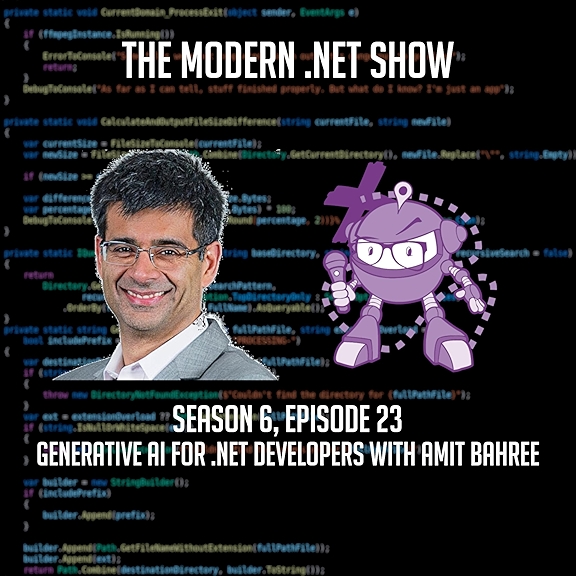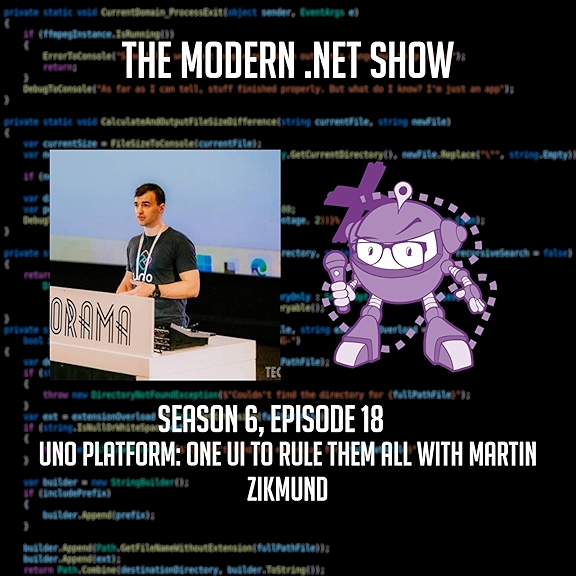27-09-2024
CQRS, System Maintainability, and Pragmatic Tech Choices with Dejan Miličić
Metalama This episode of The Modern .NET Show is supported, in part, by Metalama, reduce your boilerplate code by up to 15% with Metalama's C#-to-C# template engine and reduce your code complexity today! Show Notes "Essentially, when you look at it, what we are doing, we are not building software. We are changing it, we are maintaining it. Because when you look at the typical lifecycle of the application, enterprise one I would say, or any big system where you invest lots of time lots of money building it, you want to exploit this for 5-10-15 years hopefully. So when you look at the percentages, you're building something for one year and then you are using it for nine more years, let's say. It's a 10 year life cycle. So when you think about it, you spend 10 times... er, 10 percent of your time building something and 90 percent of the lifecycle of the application or the system responding to change requests, building new things, changing, adapting, and maintaining. So essentially, our job is not to build out. Our job is to sustain all these request changes. I think that's the first point we need to clear."— Dejan Miličić Welcome friends to The Modern .NET Show; the premier .NET podcast, focussing entirely on the knowledge, tools, and frameworks that all .NET developers should have in their toolbox. We are the go-to podcast for .NET developers worldwide, and I am your host: Jamie "GaProgMan" Taylor. In this episode, Dejan Miličić joined us to talk about the CQRS pattern, how it came from CQS, what CQS is and how it's related to Alan Kay's original ideas for object-oriented programming, being pragmatic as developers and engineers, the importance of system design and system's thinking, and how we all need to realise that our software lives on for years after we've pushed our changes to the repo. "So I, indeed, agree with you that people should pay more attention to system design. Start looking at the whole picture. And the extreme of this thinking would be: okay you will go into job interview, they will ask you about, I don't know, quick sort you, will implement it on the whiteboard, and then six months later on you will go and purchase or maybe download a NuGet package with with a quick sort implementation, because you know it makes sense; you don't want to implement something that have been implemented this many times before."— Dejan Miličić Whilst this episode doesn't focus on .NET per se, I think that the subjects that Dejan and I covered are incredibly important for anyone who wants to seriously level up their game. In fact, Dejan proved this point when he said: "We [are] all, like, containerised into our own small silos and working on our own without being aware of the whole system. When you look at what people go through when they prepare for job interviews at, I don't you know, Google, Facebook, nowadays Meta, Microsoft, you have all these books on the system design. And then they go, instead of, you know, going to the job interview after 20 years of experience and talking about what you do and what you know, people with 20 years of experience still sit down and learn and prepare for the system design interview. I'm not saying they shouldn't be preparing, but some of my colleagues told me that that was the first time in their careers that they started looking at the system design as a discipline."— Dejan Miličić Anyway, without further ado, let's sit back, open up a terminal, type in `dotnet new podcast` and we'll dive into the core of Modern .NET. Supporting the Show If you find this episode useful in any way, please consider supporting the show by either leaving a review (check our review page for ways to do that), sharing the episode with a friend or colleague, buying the host a coffee, or considering becoming a Patron of the show. Full Show Notes The full show notes, including links to some of the things we discussed and a full transcription of this episode, can be found at: https://dotnetcore.show/season-7/cqrs-system-maintainability-and-pragmatic-tech-choices-with-dejan-milicic/ Useful Links Dejan on Twitter: x.com/dejanmilicicDejjan on LinkedIn: linkedin.com/in/dejanmilicicMusic created by Mono Memory Music, licensed to RJJ Software for use in The Modern .NET ShowEditing and post-production services for this episode were provided (in part) by MB Podcast Services Supporting the show: Leave a rating or reviewBuy the show a coffeeBecome a patron Remember to rate and review the show on Apple Podcasts, Podchaser, or wherever you find your podcasts, this will help the show's audience grow. Or you can just share the show with a friend. And don't forget to reach out via our Contact page. We're very interested in your opinion of the show, so please get in touch. You can support the show by making a monthly donation on the show's Patreon page at: https://www.patreon.com/TheDotNetCorePodcast.




















